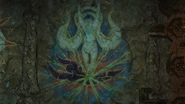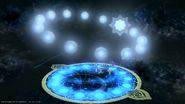Template:Sideicon
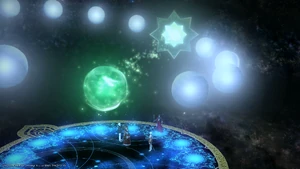
A visual representation of the Fifth shard being Rejoined to the Source in the First Umbral Calamity.
Zodiark longeth to be made whole. For His restoration, for His resurrection, His servants labor without cease. They seek to tear down the barriers which surround the Source. Thus do they rejoice in their Ardor─in your calamities─for each marks a Rejoining. Seven times have they succeeded. Seven times hath the Darkness grown stronger. Seven times have I failed.
The Word of the Mother, speaking for Hydaelyn
An Umbral Calamity (also called the Ardor or the Rejoining) is a recurring phenomenon in Final Fantasy XIV. Throughout the millennia, a procession of seven Calamities have wracked the world of Hydaelyn, each possessed of a different elemental aspect, and the majority of which brought ruin to the civilizations of Eorzea in their era.
In the wake of these Calamities are short periods of disarray as the peoples of the land struggle to recover from the devastation known as "Umbral Eras," with the subsequent "Astral Eras" referring to the realm's return to peace and prosperity before the next Calamity occurs.
Each Calamity marks the Rejoining of one of the thirteen reflections of the planet Hydaelyn to the Source, killing all life on the reflection in addition to the widespread devastation experienced on the Source. It is the primary goal of the Ascians to reunite all thirteen shards to resurrect their deity, Zodiark.
History
First Umbral Calamity
The First Umbral Calamity or Calamity of Wind marked the beginning of modern history on Hydaelyn, heralding the First Umbral Era. While scholars once debated on the elemental aspect of this Calamity, the coming of the Sixth Umbral Era allowed scholars to determine that the First Umbral Calamity was one of wind─possibly in the form of terrible hurricanes, tempests, or tornadoes.
The tale of Good King Moggle Mog XII seems to allude to the events of this Calamity, telling of a time when the skies that were once home to all moogles became embroiled in a battle between the gods. Good King Moggle Mog XII helped his brethren flee to the safety of the lands beneath the clouds, though he was forced to remain behind. The moogles of Moghome have also spoken of a wind-driven disaster previous to the first five calamities, seemingly corroborating the events of the legend.
The First Umbral Calamity was responsible for Rejoining the Fifth shard to the Source.
Second Umbral Calamity
The Second Umbral Calamity or Calamity of Lightning came on the heels of the First Astral Era, an age where mankind learned to forge stone tools and established settlements and towns, which grew into kingdoms that soon went to war, each seeking to expand their domain. To forge their tools and weapons, mountains were gutted and skies blackened.
Nature was despoiled for countless years until the balance tipped. Volcanoes spewed black smoke that covered the skies and plunged the realm into eternal darkness. Bolts of lightning rained down from the skies for a full year and a day, forcing mankind to seek shelter underground in caverns. These caves became breeding grounds for pestilence and plague. In their desperation, the people prayed for salvation, giving birth to the earliest forms of magical incantations.
The Second Umbral Calamity was responsible for Rejoining the Twelfth shard to the Source.
Third Umbral Calamity
The Third Umbral Calamity or Calamity of Fire resulted from the dramatic shift to religious worship in the realm that followed the decline of kingdoms and discovery of magic. These churches became as corrupt and powerful as the kings that preceded them, and their desire for control began an age of holy wars, witch hunts, and genocide.
Theologians believe that the gods grew weary of mankind's hubris and decided to humble them. The sun grew large and an intense heat parched the land. Wildfires spread, reducing fields and forests to wastelands, the people stricken with famine. Fossil evidence found in the desert Grand Wake in Thanalan suggests that the deserts that now make up southern Eorzea were once a lush grassland lost in the fires of this Calamity.
The Third Umbral Calamity was responsible for Rejoining the Second shard to the Source.
Fourth Umbral Calamity

Amon wove temporal magicks that preserved himself, Xande, and all others within the Crystal Tower until it was unearthed by the Seventh Umbral Calamity.
The Fourth Umbral Calamity or Calamity of Earth brought the fall of the ancient Allagan Empire that dominated the Three Great Continents throughout the Third Astral Era. At the end of Allag's reign, they had resurrected their first emperor, Xande, to revitalize their stagnant society. He entered his nation into a long and bloody war of conquest against the southern continent of Meracydia, seizing victory after forging a pact with a powerful voidsent known as the Cloud of Darkness.
Xande imprisoned his enemy, the elder primal Bahamut, within an artificial satellite later known as Dalamud with the intent of harnessing the primal's aether and funneling it into the Syrcus Tower to rip open a massive voidgate and allow the Cloud of Darkness to usher in an age of strife and chaos. Though citizens of Allag, including Warriors of Light, marshaled a resistance against him, chasing Xande from his imperial palace, they were unable to prevent him from activating Dalamud.
While the Syrcus Tower had been fortified to handle the immense aether being funneled into it, the ground beneath it cracked and broke, giving way and setting off a chain reaction of temblors that shook the entire realm, toppling mountains and tearing the land asunder. The Allagan Empire's power grid was destroyed as the Syrcus Tower, its primary power source, sank beneath the earth. Xande and his followers remained within the tower, saved by powerful time magicks woven by Amon.
The Fourth Umbral Calamity was responsible for Rejoining the Third shard to the Source.
Fifth Umbral Calamity
The Fifth Umbral Calamity or Calamity of Ice is shrouded in mystery, much like the preceding Fourth Astral Era. It began the Age of Endless Frost, a seemingly endless winter that brought raging snowstorms and giant rivers of ice. Much of the Bloodbrine Sea located north of Eorzea was frozen solid and massive icebergs appeared even as far south as the Sea of Jade east of Gyr Abania. The Miqo'te tribes, once exiled to Ilsabard by the Allagan Empire nearly two millennia prior, migrated en masse, crossing the peaks of Gyr Abania that previously prevented their return.
The Fifth Umbral Calamity was responsible for Rejoining the Sixth shard to the Source.
Sixth Umbral Calamity
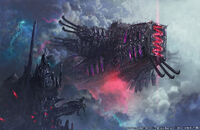
The Void Ark was meant to ferry the people of Mhach to their new home, the floating island city of Dun Scaith.
The Sixth Umbral Calamity or Calamity of Water brought an end to the War of the Magi that waged for two and a half centuries. In the year 1510 of the Fifth Astral Era, the Battle of Amdapor ended in a stalemate as the voidsent Diabolos was sealed by the white magi of Amdapor. Not long after, the scholars and seers of the realm brought word that a massive flood was about to occur, believed to be a result of the overuse of the land's ambient aether by white and black magi leaving an overabundance of water-aspected aether.
A massive deluge swept over Eorzea, destroying the city-states of Nym and Mhach while the peoples of the realm sought higher ground. The people of Nym fled to the mountains of O'Ghomoro, while their Royal Marines empowered defensive wards around their maritime city. This proved ineffective, protecting Nym from the first tidal wave only for it to be swept away in subsequent ones.
Though most citizens from the realm fled to the peaks of Gyr Abania, the magi of Mhach also created the Void Ark in a vain attempt to escape the destruction. The elementals, silent throughout mankind's despoiling of the realm's aether, overtook the abandoned ruins of Amdapor, transforming its surrounding area into South Shroud and hiding its structures behind elaborate glamours.
As the floodwaters rose, those traveling to Gyr Abania became lost in the dark of night, but spied a streaking comet in the night's sky. Seeing this as the symbol of Rhalgr, the Destroyer, they followed its light to the safety of the highlands. The descendants of these refugees would later go on to found the Fist of Rhalgr and the city-state of Ala Mhigo, and both would largely adopt the comet in their cultural symbolism.
During the devastation came a group of saviors from abroad known as the Twelve Archons. Heroes akin to the Warriors of Light in their day, they saved countless people from the flood. Among them, Nyunkrepf Nyunkrepfsyn, a Roegadyn from the Northern Empty, came to Eorzea aboard a great vessel known as Nyunkrepf's Hope intent on saving as many people from the rising waters as possible. When a great wave threatened to capsize his vessel, he teleported his charges away. Though he intended to transport them to his homeland in the northern seas, they were moored in the peaks of Gyr Abania instead. Once people began to battle one another over resources, he took his charges across Abalathia's Spine, setting sail for the northern seas where their descendants later founded the nation of Sharlayan.
To stem the tumultuous aetheric currents of the realm, magi of Amdapor and Mhach came together and created a massive ziggurat. These magi, with the aid of an Elezen fencer named Count Ganelon, founded the art of red magic to preserve their respective arts without need of ruining the environment. However, the art largely died out after the Sixth Umbral Era possibly due to the abundance of witch hunts and persecution of the learned, or due to the notorious difficulty of mastering the art.
The Sixth Umbral Calamity was responsible for Rejoining the Tenth shard to the Source.
Seventh Umbral Calamity
Because each of the previous Calamities corresponded to one of the six elements, scholars of the Sixth Astral Era believed the worst was behind them. However, the Divine Chronicles written by the seeress Mezaya Thousand-Eyes prophesied the coming of a Seventh Umbral Era. While most scholars dismissed this as apocrypha, Louisoix Leveilleur, a prominent Archon of Sharlayan, heeded this warning. Together with eleven students and colleagues, fellow Archons all, he formed the Circle of Knowing to forestall the coming Calamity by reforming the realm's Grand Companies.
The architect of the Seventh Umbral Calamity was the Garlean Empire. Hungry for conquest over Eorzea in the wake of their victory over Ala Mhigo, they began researching a way to harness the lesser of the planet's two moons, Dalamud, as a weapon. Using an ancient Allagan lunar transmitter passed down to VIIth Legion legatus Nael van Darnus, Solus zos Galvus commissioned the Meteor Project. Midas nan Garlond became engrossed in his research and, in the year 1562, a surge of energy struck his research facility in Citadel Bozja, wiping out the city and all its inhabitants. After this catastrophe, the Meteor Project was shelved, Nael van Darnus sent to the eastern theater.
Ten years later, Nael returned to the emperor claiming he could control the lesser moon's descent. Dispatching VIIth Legion forces into Eorzea, Darnus began seeking Allagan relics and built Castrum Novum in Mor Dhona to house the lunar transmitter. Darnus began redirecting the planet's aetherial currents to Dalamud, using the summonings and defeats of primals to fuel the moon's descent. The XIVth Legion stationed in Ala Mhigo was made to aid Darnus in seeing the project to fruition, despite the misgivings of their legatus Gaius van Baelsar. The reformed Eorzean Alliance and its Grand Companies laid siege to Castrum Novum, while a party of adventurers infiltrated the castrum and destroyed the transmitter.
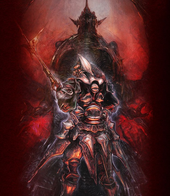
Though the White Raven was slain at Rivenroad, the soul of Nael van Darnus remained enthralled to Bahamut until the early Seventh Astral Era.
Darnus had gained the ability to wield magic heretofore impossible for Garlean purebloods, using it to pull Dalamud from the heavens. With the aid of Midas's son, Cid Garlond, the adventurers made their way to Coerthas, where Darnus had raised a series of floating islands known as Rivenroad, and laid the mad legatus low.
Even this failed to halt Dalamud's descent, however, spurring Archon Louisoix to entreat the realm's denizens to pray at places he marked with the symbols of the Twelve. He ventured to Carteneau Flats, where he began amassing an incredible amount of aether through his stave, Tupsimati, in preparation to summon the primal incarnations of the Twelve.
Gaius van Baelsar warned the adventurer that the remnants of the VIIth Legion would go to Carteneau to see their fallen leader's plan to completion, ignorant of their impending doom. The Eorzean Alliance marshalled a defense of Louisoix to ensure his summoning went uninterrupted.
When the moon neared the planet's surface, rather than make direct impact, it burst open in spectacular fashion. The elder primal Bahamut, released from five millennia of captivity, unleashed his infernal wrath upon the realm as Eorzean and Garlean alike fled from the raining debris of the artificial satellite.
Louisoix, using the aether he gathered for summoning, attempted to weave a cocoon of light around Bahamut to seal him once more, yet the furious primal broke free. Louisoix invoked the power of Althyk, the Keeper, and sent those adventurers who defeated Darnus and stood valiantly beside him at Carteneau into an aetherial rift from which they would not emerge for five years.
In the moments before Bahamut could fully devastate the realm with his Teraflare, Louisoix gathered what aether he possessed and transformed into a primal formed of the realm's desperate pleas for rebirth. As Phoenix, Louisoix tore through Bahamut's attack, bursting it and spearing through the elder primal's chest. As he regained his original form, dying from overuse of his own aether, Louisoix returned as much of the aether he'd gathered to the land as possible to accelerate its revitalization in the coming years.
As the mortally-wounded Bahamut fell to earth, he dragged Louisoix down as well and tempered him to his will. Bahamut would spend the next five years in the depths of Eorzea, regenerating due to the Allagan technology meant to sustain him while he was trapped within Dalamud.
The Seventh Umbral Calamity was composed of all elements in astral alignment and was responsible for Rejoining the Seventh shard to the Source.
Eighth Umbral Calamity
The Eighth Umbral Calamity occurred in an alternate timeline during the early Seventh Astral Era. After the liberation of Ala Mhigo and Doma, the Garlean forces began invading Eorzea at the Ghimlyt Dark. As the Eorzeans kept the Garleans at a stalemate, the Empire unleashed a deadly gas known as Black Rose that halted the aetherial flow in any who come into contact with it. It had the correct aspect to coincide with and feed from the steadily seeping, umbrally-aligned aether of the First. The already-deadly gas exploded into a calamitous cloud of death that covered much of Aldenard and Ilsabard due to the First being swept into the Source and Rejoined.
The Calamity spelled an end not only to the civilizations of Eorzea but also the Garlean Empire. Survivors included Cid Garlond, who continued operating Garlond Ironworks. Inspired to undo the Eighth Ardor, he used the concepts of traversing the rift observed in his encounters with Omega and the time travel theory observed in his encounters with Alexander to work out a way to traverse time and space to reach the First before its Rejoining. The heroism of the Warrior of Light, who perished in the Calamity, inspired many people of the realm to lend support to the project, as stories of the legendary hero kept hope alive in these dark days.
The research passed to a descendant of Biggs, who awakened G'raha Tia within the Crystal Tower two hundred years after the Calamity while looking to use the tower as a vessel. Together, they decided that they would travel to a time after the hero's victory in the Dragonsong War, and that G'raha, having control over the Crystal Tower, would travel within it to the First.
Because time flows differently between the Source and its shards, G'raha Tia arrived one-hundred years prior to the desired time, but survived under the identity of the Crystal Exarch to eventually call the Warrior of Light to the First. The Warrior of Light, under the mantle of Warrior of Darkness, returned balance to Norvrandt, removing the calamitous potency of Black Rose on the Source before it could be employed and preventing the First from being used for the Rejoining, thus averting the Eighth Umbral Calamity altogether.
Purpose
The Great Sundering
The Calamities are a result of the Ascians' efforts to return the world of Hydaelyn to its original state. Over 13,000 years ago, the progenitor race of man known as the Ancients suffered a catastrophe known as the Final Days. Their leaders, the Convocation of Thirteen, averted this by the summoning of the primal Zodiark, will of Darkness.
After using Zodiark to halt the Final Days and restore vitality to the ruined land, the Convocation intended to use Zodiark to resurrect those who died in the Final Days by nurturing and sacrificing the new lives born into the world. Those who disagreed with this, led by Venat, summoned the primal Hydaelyn, will of Light. The two fought nigh endlessly and, though Zodiark was the stronger, Hydaelyn used Her ability to sunder beings on Her counterpart and bound Him within the moon. This split the Star across the Source and its thirteen reflections in an event known as the Great Sundering.
The Great Rejoining
Elidibus, Lahabrea, and Emet-Selch of the Convocation of Thirteen survived the sundering intact and uplifted their cohorts. Later known by the races of man as "Ascians," they labored to reunite the Source with its sundered shards, seeing no value in the billions of lives that now dwelled upon them.
The Ascian Igeyorhm first attempted the Rejoining on the Thirteenth, but her overzealous defeat of its Bringers of Light, such as Unukalhai and Cyella, caused the shard, already predisposed to activity and growth, to tip inexorably towards Darkness. A Flood of Darkness overtook the Thirteenth, purging it of aether and reducing it to a shadowy Void and its denizens to aether-starved monsters known as voidsent.
Failing to Rejoin the Thirteenth, the Ascians discovered a means by which they could reunite the Source and its shards. By creating havoc of an elemental aspect on a shard, they could create a crack in the dimensional barrier between it and the Source, causing aether to trickle back into it. By simultaneously causing a catastrophe of the same aspect on the Source, the barrier would break, pulling the whole of the shard into the Source.
Though these Rejoinings cause widespread devastation on the Source, taking countless lives each time, they also benefit the Source in unseen ways, empowering its denizens' souls with the stolen lives of their counterparts on the shards. This is of secondary note to the Ascians, as each Calamity weakens Hydaelyn by damaging Her directly while empowering Zodiark by reuniting him with His dimensional counterparts, hastening the return of their "one true God."
Once all of the shards are Rejoined to the Source, the Ascians intend to sacrifice all lives left upon it to Zodiark in an event they refer to as the Great Rejoining, that He might return to life all those Ancients who perished in the Final Days precisely as they were at the height of their civilization.

